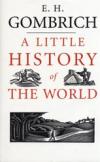What to Tell the Kids?
In 1935, a 26-year-old Viennese Jew with a Ph.D. in art history, but no job, hastily penned Eine kurze Weltgeschichte für junge Leser, as part of a series called Knowledge for Children, before fleeing to England, where in time he became director of the Warburg Institute and the celebrated author of The Story of Art, Art and Illusion and other works. Now, four years after his death, this charming opusculum (which the Nazis banned for being too pacifistic) has been ably translated by Sir Ernst’s last assistant, Caroline Mustill.
Charming history? Without, shall we say, a massive cover-up? Gombrich, in fact, reveals both a warm, but never patronizing, authorial voice and quiet honesty as he takes his young readers on a journey from the Stone Age to the eve of World War II. (In a fittingly dark final chapter, added over half a century later, titled The Small Part of the History of the World Which I Have Lived Through Myself, Gombrich reflects on the Holocaust and other horrors that he failed to anticipate in his first go-round.)
More or less inevitably, Gombrich’s history is Euro- and Germano-centric, although he makes a conscientious effort to be inclusive. So we hear relatively a lot about Theodoric and Odoacer, Henry IV and Pope Gregory VII, Emperor Fredrick II, all sorts of Habsburgs, Frederick the Great, Metternich and Bismarcknone of which would harm any bright American middle-schoolers who happened to leaf through the book.
For clarity and convenience’s sake, Gombrich sticks mostly to the Great Men as his guideline, though he stops often enough to remind us of the wretched living conditions among the masses. Speaking of the pampered aristocrats at Versailles, he writes: But if a noble landowner happened to leave the palace and go home to his estate, it was even worse for the peasants. For he and his attendants would rampage across the land after hares and foxes, their horses’ hooves trampling the carefully tended fields. And woe betide the peasant who protested! This mildly socialist perspective peaks in a forceful account of the dilemmas faced by workers in the 19th-century labor market.
But mostly Gombrich sticks to broad, vivid, nonpolitical tableaux: They [the Vandals] ravaged Sicily and crossed into Italy. Today we still talk of vandalism,’ even though the Vandals really were no worse than many others. As for the Huns, they were worse. The writing is crisp, bright and sometimes witty: If you weren’t a Christian, a Jew or a close relative of the emperor, life in the Roman empire could be peaceful and pleasant. Adults who have not cracked a history book since college needn’t feel embarrassed if they scan Gombrich to remind themselves how Luther escaped death after the Diet of Worms or the way Napoleon divvied up Europe among his relatives.
A secularist himself, Gombrich is steadily ecumenical and positive in his treatment of religion (though he casually passes on the old canard about Caliph Omar burning down the library of Alexandria). In a startling cross-cultural comparison he notes, Like the Buddha, Ignatius [Loyola] wished to rid himself of all desire. But rather than seeking release from human suffering here on earth, he wanted to devote himself, body and soul, to the service of the Church. The only faith Gombrich personally espouses and preaches here is in the Enlightenment trinity of tolerance, reason, and humanity. But then in his afterword he is forced to admit that the extremes of cruelty and persecution he thought had been vanquished forever roared back into hideous life in the 1940’s. All that notwithstanding, he gamely ends with an insistence on our right to go on hoping for a better future. That much, at least, would seem to be de rigueur in a children’s bookone can’t very well sign off with James Joyce’s History is a nightmare from which I am trying to awake.
Any universal history, even a juvenile one, is bound to raise complaints about sins of omission and commission. Gombrich has unfortunately little to say about women. Surprising for an art historian, he almost never mentions artists (except for Leonardo, and then more as a scientist). Instead, he sticks to more readily graspable topics like changing fashions in houses, clothes and manners. He sometimes recycles dubious generalizations (e.g., the monks clear[ed] useless forests for civilization). He mostly neglects America, and readers who did not know better might get the impression that the Revolution was led by our twin monarchs, George Washington and Benjamin Franklin.
But these are minor flaws, more than offset by Gombrich’s lucidity and liveliness. And then there are the quirky surprises, like the bit of echt Viennese melancholy in his history-as-a-river summation: Over and over again, new bubbles come to the surface, and then vanish in time with the waves. For a brief instant they are lifted on the wave’s crest and then they sink down and are seen no more. We are like that. A distinctly old-worldish, if not biblically pessimistic, view. One wonders how many tween and teen Americans could be dragged away from the TV or the Internet or their iPods to think about it. Of course, there’s nothing to stop us.
This article also appeared in print, under the headline “What to Tell the Kids?,” in the February 27, 2006, issue.








